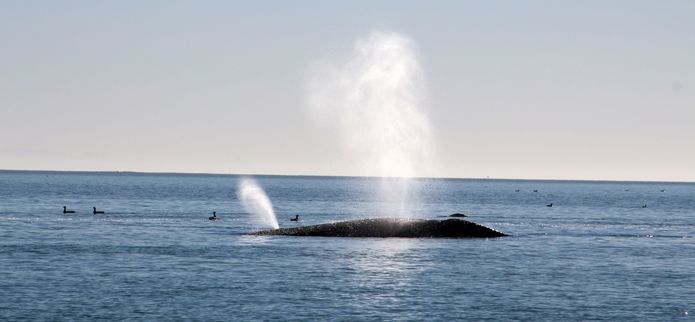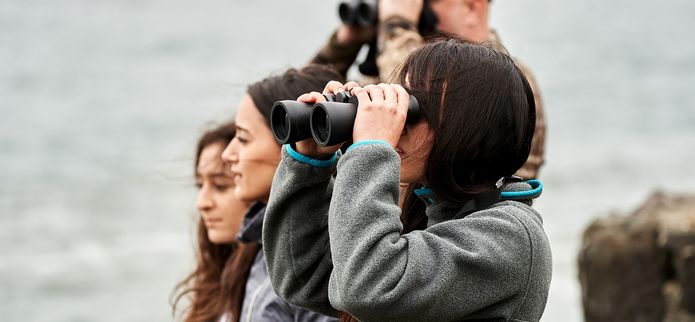Oregon Whale Watch Week Returns to Oregon’s Adventure Coast!

Oregon Winter Whale Watch Week Returns December 28, 2022 – Sunday, January 1, 2023
We have great news for whale watchers: after a two year hiatus, Oregon Whale Watch Week is back! Thanks to the knowledgeable volunteers from the Whale Watching Spoken Here® program, Oregon Coast visitors can learn more about the mysterious and awe-inspiring gray whales and their annual migration in designated Whale Watching Spoken Here® sites (like Shore Acres State Park ) between 10am and 1pm December 28, 2022 – Sunday, January 1, 2023.
Bring your binoculars, you just may witness the beautiful sight of gray whales blowing, breaching and fluking as they pass by, and don’t forget to dress in layers and bring a waterproof coat!
 While you’re here, we recommend exploring the beaches and state parks along the Cape Arago Highway Loop,
and looking for the famous seals and sea lions! Some of our favorite spots on the loop include Sunset Bay State Park, Bastendorff Beach, Simpson Beach, and, of course, Shore Acres State Park. There is a 6-mile hiking trail loop from Sunset Bay Cove to Cape Arago State Park that takes you along dramatic cliffs, into the coastal forest, and down to the tide pools and beaches.
While you’re here, we recommend exploring the beaches and state parks along the Cape Arago Highway Loop,
and looking for the famous seals and sea lions! Some of our favorite spots on the loop include Sunset Bay State Park, Bastendorff Beach, Simpson Beach, and, of course, Shore Acres State Park. There is a 6-mile hiking trail loop from Sunset Bay Cove to Cape Arago State Park that takes you along dramatic cliffs, into the coastal forest, and down to the tide pools and beaches.
Did you know that gray whales travel up to 12,000 miles (round trip) on their journey from the Arctic Ocean to Mexico and back each year? Here are some other interesting facts about gray whales we’ve learned from orwhalewatch.org .
- Gray whales can grow up to 45 feet long and weigh up to 70,000 pounds!
- Whalers nicknamed the Grays “Devil Fish” because they fought so hard to defend their babies. Today, they are best known for being friendly to people.
- The reason for the migration south is to give birth to their young in the warm, calm bays of Mexico.
- Gray Whale babies are 15 feet long and weigh 2,000 at birth.
- They return north and spend the summer feeding in the Bering and Chukchi Seas (they seldom eat during migration).
- Researchers estimate that 18,000-plus gray whales now live in the eastern North Pacific area. About 30 whales per hour migrate past the Oregon coast during the peak southbound migration. By comparison, six per hour pass by on the northbound trip, but that return trip is spread over four months. Some 200-plus of these whales drop off the migration route and feed along the Oregon coast all summer.
- About 200 Gray Whales don’t continue to Alaska, but stay along the Oregon Coast to feed.
- Grays have baleen plates instead of teeth, with 130-180 plates or pieces along each side of the upper jaw.
- They take great mouthfuls of food-laden water. Then, using their tongues, they squeeze out the water and swallow the food that sticks to the baleen.
- The Oregon coast produces lots of phytoplankton (small marine plants) eaten by zooplankton (small marine animals), including bottom dwelling amphipods and mysid shrimp – primary food of the Gray Whales.
- The only natural predators of Gray Whales are Orcas (killer whales) and large sharks. Even though some countries are still whaling, the biggest threat to the whales is pollution in the oceans.
Click here for local lodging options, and be sure to download the Oregon Parks and Recreation Department whale watching brochure to learn more!
Here are some other adventures and trip ideas to consider during your visit to Oregon’s Adventure Coast: Coos Bay, North Bend, Charleston.
- Storm Watching
- Winter Fun On Oregon’s Adventure Coast
- Southern Oregon Coast Lighthouses
- Charleston to Bandon Tour Route
- Crabbing and Clamming
- One-Day Travel Itinerary: A Perfect Adventure in North Bend, Oregon
- Oregon Dunes National Recreation Area
- Day By Day, Like Travel Writer, Nancy Brown
- Art, History & Culture
- Untamed Dunes & ATV’ing & Motorsports
- Undeveloped Beaches
- Shopping
- Birding & Wildlife
- State Parks & National Lands
- Fishing
- Gaming
- Cycling
- Ocean Life & Tidepooling
- Theatres
- Entertainment & Nightlife
